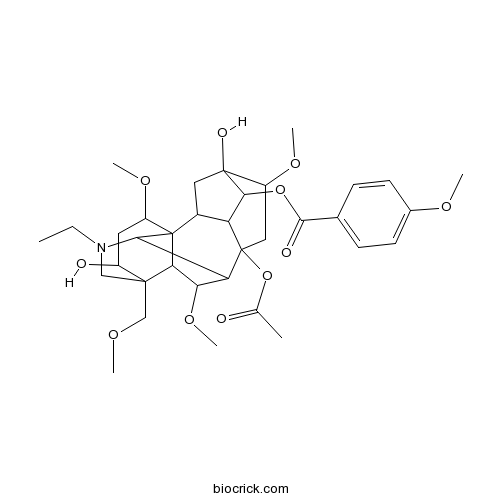Aconitum vilmorinianum
Aconitum vilmorinianum
1. The products in our compound library are selected from thousands of unique natural products; 2. It has the characteristics of diverse structure, diverse sources and wide coverage of activities; 3. Provide information on the activity of products from major journals, patents and research reports around the world, providing theoretical direction and research basis for further research and screening; 4. Free combination according to the type, source, target and disease of natural product; 5. The compound powder is placed in a covered tube and then discharged into a 10 x 10 cryostat; 6. Transport in ice pack or dry ice pack. Please store it at -20 °C as soon as possible after receiving the product, and use it as soon as possible after opening.
Natural products/compounds from Aconitum vilmorinianum
- Cat.No. Product Name CAS Number COA
-
BCN6261
Yunaconitine70578-24-4
Instructions

New norditerpenoid alkaloids from Aconitum vilmorinianum Komarov.[Pubmed: 26126770]
Aconitum vilmorinianum Komarov is a local medicinal plant used in many well-known clinical preparations to treat rheumatism and pains in Yunnan Province, China. Phytochemical examination of the roots of A. vilmorinianum led to the isolation of three novel imine-type norditerpenoid alkaloids named vilmorrianines E-G (1-3), and a new natural alkaloid N-desethyl-N-formyl-8-O-methyltalatisamine (4), together with 14 known alkaloids. Their structures were elucidated on the basis of spectroscopic evidence. Vilmorrianine E is the first known norditerpenoid alkaloid containing both an imine group and a three-membered ring formed by C8, C9, and C10.
Diterpenoid alkaloids from Aconitum vilmorinianum.[Pubmed: 26021734]
Diterpenoid alkaloids, named vilmorines A-D, in addition to fifteen known alkaloids, were isolated from roots of Aconitum vilmorinianum. Their structures were established on the basis of extensive spectroscopic analyses. Antibacterial and antioxidant studies on isolated compounds were also carried out.
Accelerated solvent extraction and pH-zone-refining counter-current chromatographic purification of yunaconitine and 8-deacetylyunaconitine from Aconitum vilmorinianum Kom.[Pubmed: 23784883]
This study aimed to seek an efficient method to extract and purify yunaconitine and 8-deacetylyunaconitine from Aconitum vilmorinianum Kom. by accelerated solvent extraction combined with pH-zone-refining counter-current chromatography. The major extraction parameters for accelerated solvent extraction were optimized by an orthogonal test design L9 (3)(4). Then a separation and purification method was established using pH-zone-refining counter-current chromatography with a two-phase solvent system composed of petroleum ether/ethyl acetate/methanol/water (5:5:2:8, v/v) with 10 mM triethylamine in the upper phase and 10 mM HCl in the lower phase. From 2 g crude extract, 224 mg of 8-deacetylyunaconitine (I) and 841 mg of yunaconitine (II) were obtained with a purity of over 98.0%. The chemical structures were identified by ESI-MS and (1)H and (13)C NMR spectroscopy.
[Study on ITS sequences of Aconitum vilmorinianum and its medicinal adulterant].[Pubmed: 23451494]
To analyze and compare the ITS sequences of Aconitum vilmorinianum and its medicinal adulterant Aconitum austroyunnanense.
The anti-arthritic effects of Aconitum vilmorinianum, a folk herbal medicine in Southwestern China.[Pubmed: 23439029]
Aconiti Radix (AC) and Aconiti Kusnezoffii Radix (AK) are two traditional Chinese medicines commonly used to treat joint pain and arthritis. In Southwestern China, Huangcaowu (AV), the root of Aconitum vilmorinianum Kom., has long been used as a local substitute for these herbs for analgesia and anti-inflammation. However, its anti-arthritic effects have not been investigated.


